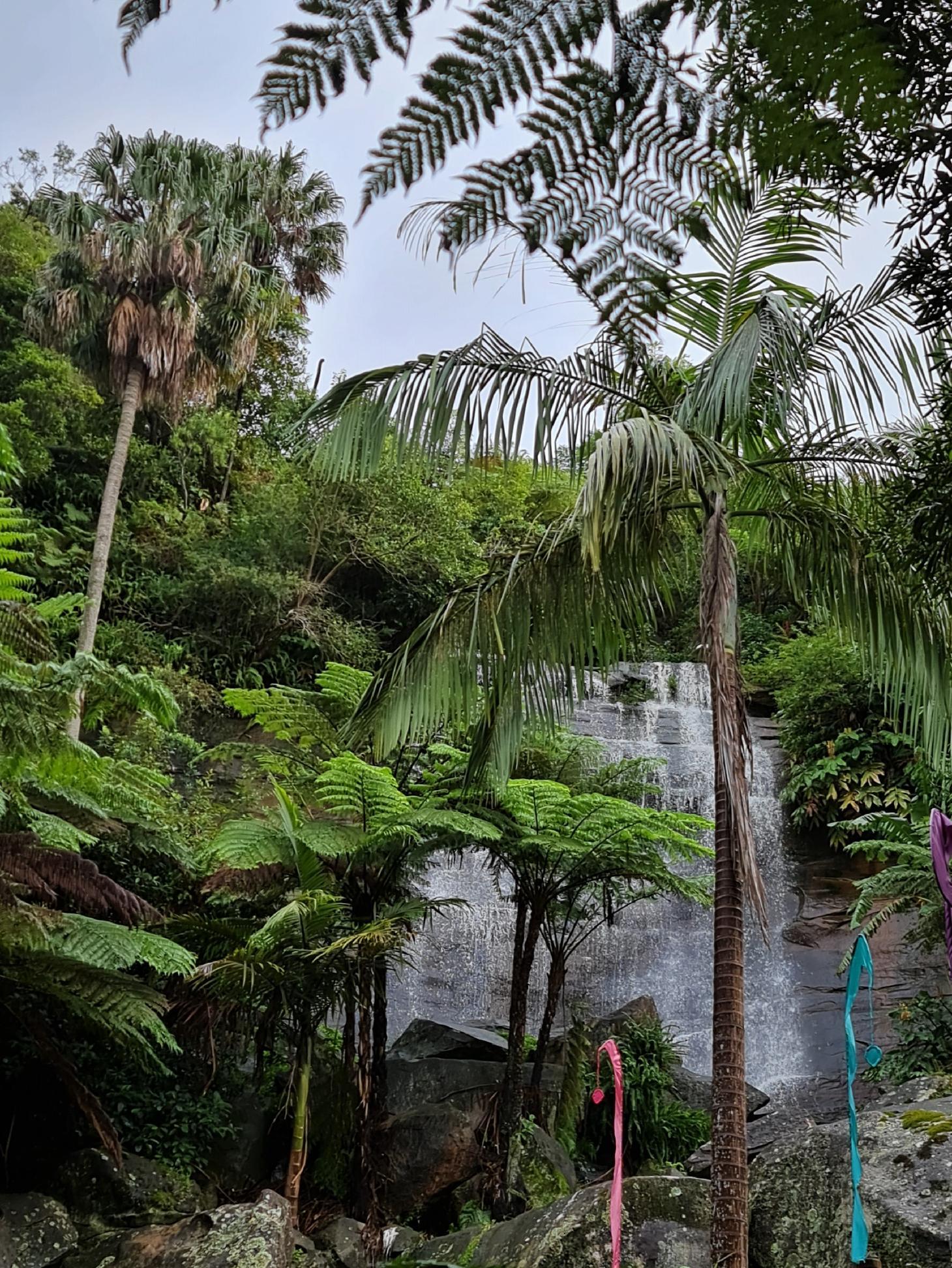October 23 - 29, 2022: Issue 559
State Of The Beaches 2021-2022 Report Released
.jpg?timestamp=1599249145859)
The latest State of the Beaches report, released October 16th, states 94% of monitored ocean beaches and 80 % of all monitored swimming spots are graded as good or very good.
While monthly rainfall totals in September and October were average to below average, the Sydney region received above average rainfall totals in Spring 2021 due to a wet November. Mona Vale recorded more than double the long-term monthly average rainfall for November with 203 mm.
Summer 2021–2022 rainfall totals were above average, with February notably wet. Sydney (Observatory Hill) recorded its wettest summer since 1991–1992 with 655 mm of rain over Summer. Collaroy had its highest February rainfall total on record with 419 mm, and Randwick and Rose Bay had their highest total February rainfall since 1990, with 422 mm and 409 mm respectively. Heavy downpours in February resulted in flash flooding across Sydney.
March 2022 was the wettest March on record in many areas of Sydney. Mona Vale and Collaroy had their highest March rainfall totals on record with 577 mm and 686 mm of rain for the month, respectively.
Residents will recall Surf Life Saving NSW cancelled the State Championships being held at North Steyne and Queenscliff after teeming rains in late February, and the forecast of more heading into the March weekend scheduled competitions. The Junior competitions that went ahead as the conditions hit saw numerous children falling ill with gastro enteritis.
An abridged timetable for the other Age Divisions was eventually abandoned(The 2022 NSW Age Surf Life Saving Championships + Schedule Changes Due To Weather Forecast For Coming Week).
On Monday March 7th, 2022 SLS NSW released a statement which read:
'Surf Life Saving NSW has made the difficult decision to cancel the remainder of the 2022 NSW Surf Life Saving Championships, proudly supported by Your local club.
This decision has been made in the interests of competitor safety and wellbeing. In considering the impact that the recent and continuing extreme rainfall has had on water quality and clarity, the impact that large swells have had on the beaches as well as a forecast for hazardous surf conditions for the remainder of this week, it was the strong recommendation from the Championship Safety Committee that it would not be safe to proceed with the event.
This has been an extremely challenging and difficult set of circumstances for the Championship Committee to contend with over the last few weeks. SLSNSW had been hopeful that the original postponement of the Open and Masters events would allow the Championships to continue and we are extremely disappointed that despite the best efforts of everyone involved in the planning and conduct of the Championships, it is clear that the weather will not improve sufficiently, nor is the beach environment safe from the past two weeks of extreme rainfall. Additionally, the involvement of many key volunteers in the flood rescue effort has put a significant strain on the ability to ensure the required level of water safety is in place for the event. The Championship Committee believes it appropriate to make the decision to cancel now, to ensure all participants can make changes to their various travel plans.'
The State of the Beaches 2021-2022 report graded Queenscliff as 'Good' overall but notes; ''microbial water quality is considered suitable for swimming most of the time but may be susceptible to pollution after rain, with several potential sources of faecal contamination, including discharge from Manly Lagoon. Enterococci levels increased with increasing rainfall, occasionally exceeding the safe swimming limit after light rain, and regularly after 10 mm or more.''
North Steyne, similarly ranked 'Good' in the current report, is also ''considered suitable for swimming most of the time but may be susceptible to pollution after rain, with several potential sources of faecal contamination including stormwater and discharge from Manly Lagoon. Enterococci levels generally increased with increasing rainfall, occasionally exceeding the safe swimming limit after 5 mm or more of rain, and frequently after 20 mm or more.''
The severe wet weather resulted in flash flooding across Sydney and major flooding of coastal waterways, including the Hawkesbury–Nepean. Beachwatch issued an extreme wet weather pollution alert on all Sydney daily beach pollution forecasts during March 2022, advising that stormwater pollution and floodwaters may be impacting swimming sites for an extended period, with lifeguard reports of floating debris and discoloured water continuing after the rain had ceased.
The wet weather continued in April 2022 with well above the long-term monthly average rainfall recorded. A heavy rainfall event was recorded on 7–8 April, with Rose Bay receiving a record high daily rainfall total for April of 167 mm, and Randwick recording 155 mm on the 7th. More than 2 and a half times the long-term monthly average rainfall was recorded at Collaroy, Randwick and Rose Bay with 302 mm, 326 mm and 379 mm, respectively.
Beachwatch monitoring showed flooding events impacted waterways beyond the flood zones, including Sydney Harbour and Sydney ocean beaches, making microbial water quality unsuitable for swimming. Routine monitoring at coastal swim sites in Sydney detected significantly elevated microbial counts at all 97 monitored swim sites, which posed an increased health risk to bathers. The most affected areas were in estuaries, such as Pittwater, which have a lower level of flushing and took longer to recover from the floodwater events than the ocean beaches. Routine water quality testing showed some sites unsuitable for swimming for up to 4 weeks
As microbial levels returned to normal at swim sites monitored by Beachwatch there was still a large amount of debris or other hazards, such as murky water, which posed a risk to recreational activities.
Water NSW reported several occurrences of marine algal blooms at Sydney beaches in late 2021. Blooms of Trichodesmium sp. and Noctiluca sp. were reported at Sydney beaches in November and December 2021, and in Sydney Harbour in November 2021. Marine algae advisories were issued on the Beachwatch and Water NSW websites.
The appearance of marine algae is sometimes mistaken for sewage contamination or oil slicks, due to a strong odour and red or brown discolouration in the water caused by the blooms.
As a precaution, direct contact with algae should be avoided as it can cause skin and eye irritations. The marine algal blooms dissipated with changes in tide and wind conditions.
Palm, Whale, Avalon and Mona Vale beaches were rated Very Good of the Pittwater ocean beaches in the current report, while Narrabeen Lagoon's Birdwood Park and Bilarong Reserve were again rated Poor, while Bayview Baths was again rated Poor in the Pittwater estuarine swimming spots. Elvina Bay and The Basin Estuarine and Great Mackerel Beach were rated Very Good among the Estuarine beaches.
This is an improvement for Elvina Bay which had been downgraded in the previous two reports.
Barrenjoey Beach remained rated 'Good' despite a high level of animal faeces showing up in the results again. The other impact on this popular swimming spot has been contamination from Hawkesbury River during the floods that have impacted the Pittwater estuary throughout the current State of the Beaches report.
The still high incidence of animal faeces on Barrenjoey Beach, where temporary toilets were introduced on the headland in January 2020 ahead of permanent facilities expected to be constructed at the end of 2022, and where public facilities are adjacent in Governor Phillip Park, and with most of the previously resident birds chased from this area during the quashed 'dog trial', could be an indication that the councils' required actions by the NSW OLG of compliance of dogs in public spaces, and particularly on this beach, where dogs are still seen offleash on a daily basis despite this being a no dogs area, is deficient. Bayview Baths, again rated 'Poor' in the latest State of the Beaches report, and directly downstream from a dogs offleash area on the tidal estuary, has the bulk of its pollution attributed to stormwater runoff, not animal faeces. Barrenjoey Beach is the only of the Pittwater estuarine beaches to show a high level of persisting animal faeces contamination.
The 2021-2022 Report also states that contamination of recreational waters with faecal material from animal and human sources can pose significant health problems to beach users owing to the presence of pathogens (disease-causing microorganisms) in the faecal material. The most common groups of pathogens found in recreational waters are bacteria, protozoans and viruses.
Exposure to contaminated water can cause gastroenteritis, with symptoms including vomiting, diarrhoea, stomach-ache, nausea, headache and fever.
Eye, ear, skin and upper respiratory tract infections can also be contracted when pathogens come into contact with small breaks and tears in the skin or ruptures of the delicate membranes in the ear or nose.
Certain groups of users may be more vulnerable to microbial infection than others. Children, the elderly, people with compromised immune systems, tourists, and people from culturally and linguistically diverse backgrounds are generally most at risk.
The full State of the Beaches 2021-2022 report for the Sydney region (PDF 15.9MB) is available here.
Pittwater Estuarine Beaches
Details from Pittwater Estuarine Beaches run below.
Barrenjoey Beach: Good
Barrenjoey Beach is approximately 1.5 km long and located on the north-eastern foreshore of Pittwater.
The Beach Suitability Grade of Good indicates microbial water quality is considered suitable for swimming most of the time but may be susceptible to pollution after rain, with several potential sources of faecal contamination.
Enterococci levels generally increased with increasing rainfall, occasionally exceeding the safe swimming limit after little or no rain, and regularly after 20 mm or more.
The site has been monitored since 1996.
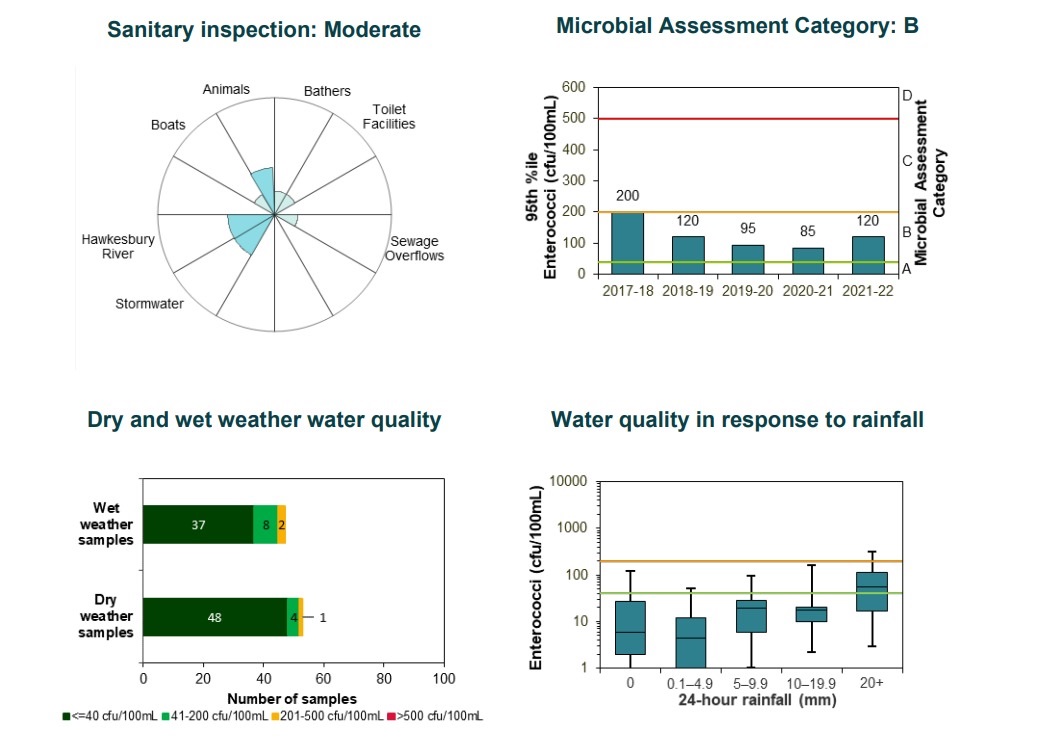
Barrenjoey Beach Graph from State of the Beaches report 2021-2022
Paradise Beach Baths: Good
Paradise Beach Baths is a 30 by 20 m netted swimming enclosure on the eastern foreshore of Pittwater.
The Beach Suitability Grade of Good indicates microbial water quality is considered suitable for swimming most of the time but may be susceptible to pollution after rain, with several potential sources of faecal contamination including stormwater.
Enterococci levels generally increased with increasing rainfall, occasionally exceeding the safe swimming limit in response to light rain, and often after 10 mm or more.
The site has been monitored since 1996.
Clareville Beach: Good
Clareville Beach is a narrow 250 m long beach located on the eastern foreshore of Pittwater.
The Beach Suitability Grade of Good indicates microbial water quality is considered suitable for swimming most of the time but may be susceptible to pollution after rain, with several potential sources of faecal contamination including stormwater.
Enterococci levels generally increased with increasing rainfall, occasionally exceeding the safe swimming limit after light rain, and often after 10 mm or more.
The site has been monitored since 1995.
Taylors Point Baths: Good
Taylors Point Baths is a 15 by 20 m netted swimming enclosure on the eastern foreshore of Pittwater.
The Beach Suitability Grade of Good indicates microbial water quality is considered suitable for swimming most of the time but may be susceptible to pollution after rain, with several potential sources of faecal contamination including stormwater.
Enterococci levels generally increased with increasing rainfall, occasionally exceeding the safe swimming limit after 10 mm or more of rain, and frequently after 20 mm or more.
The site has been monitored since 2010.
Bayview Baths: Poor
Bayview Baths is a 20 by 40 m swimming enclosure on the southern foreshore of Pittwater.
The Beach Suitability Grade of Poor indicates microbial water quality is susceptible to faecal pollution, particularly after rainfall and occasionally during dry weather conditions, with several potential sources of faecal contamination including stormwater and sewage overflows.
Enterococci levels generally increased with increasing rainfall, occasionally exceeding the safe swimming limit after little or no rain, and regularly after 10 mm or more.
The site has been monitored since 1995.
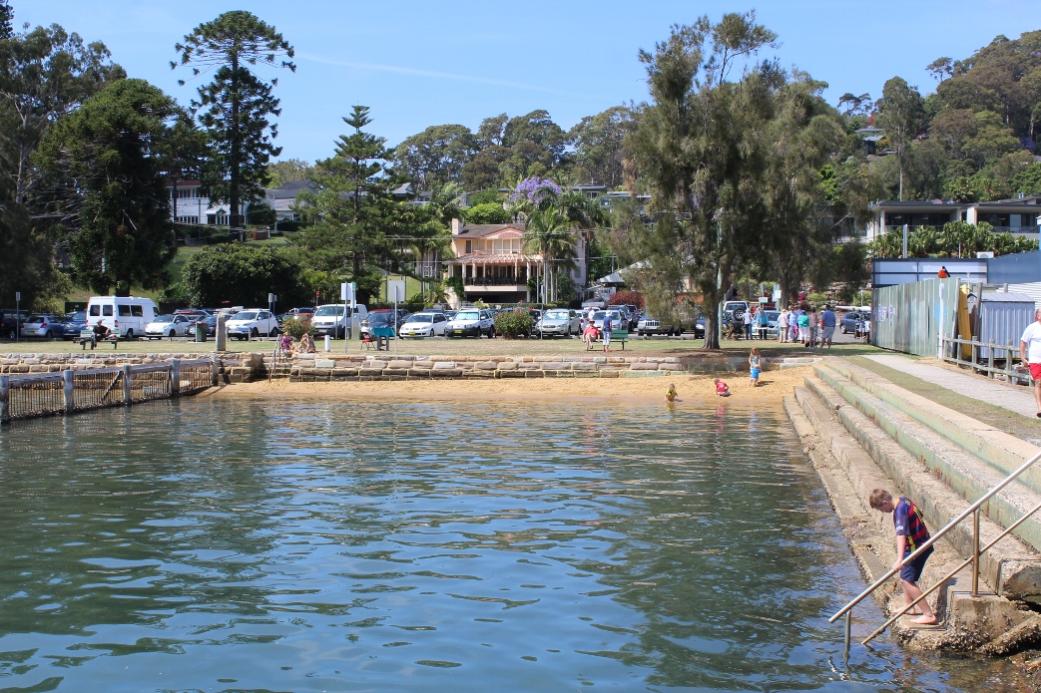
Elvina Bay: Very Good
Elvina Bay is located on the south-western foreshore of Pittwater. The swimming area is not netted.
The Beach Suitability Grade of Very Good indicates microbial water quality is considered suitable for swimming almost all of the time, with few potential sources of faecal contamination.
Enterococci levels generally increased with increasing rainfall, often exceeding the safe swimming limit after 10 mm or more of rain, and regularly after 20 mm or more.
The site has been monitored since 1995.
North Scotland Island: Good
The North Scotland Island swimming site is a 15 by 50 m netted enclosure located on the north side of Scotland Island in Pittwater.
The Beach Suitability Grade of Good indicates microbial water quality is considered suitable for swimming most of the time but may be susceptible to pollution after rain, with several potential sources of faecal contamination including onsite systems.
Enterococci levels generally increased with increasing rainfall, occasionally exceeding the safe swimming limit after 10 mm or more of rain, and often after 20 mm or more.
The site has been monitored since 1995.
South Scotland Island: Good
The South Scotland Island swimming site is located at Carols Wharf on the southern side of Scotland Island. The location is not netted and is backed by a reserve.
The Beach Suitability Grade of Good indicates microbial water quality is considered suitable for swimming most of the time but may be susceptible to pollution after rain, with several potential sources of faecal contamination including onsite systems.
Enterococci levels generally increased with increasing rainfall, often exceeding the safe swimming limit after 10 mm or more of rain, and regularly after 20 mm or more.
The site has been monitored since 1996.
The Basin: Very Good
The Basin is a 500 m sandy beach on the western side of Pittwater, backed by Ku-ring-gai Chase National Park.
The Beach Suitability Grade of Very Good indicates microbial water quality is considered suitable for swimming almost all of the time with few potential sources of significant faecal contamination.
Enterococci levels generally increased with increasing rainfall, occasionally exceeding the safe swimming limit in response to 10 mm or more of rain, and often after 20 mm or more.
The site has been monitored since 1999.
Great Mackerel Beach: Very Good
Great Mackerel Beach is a 500 m long sandy beach on the north-western side of Pittwater.
The Beach Suitability Grade of Very Good indicates microbial water quality is considered suitable for swimming almost all of the time with few potential sources of significant faecal contamination.
Enterococci levels generally increased with increasing rainfall, occasionally exceeding the safe swimming limit in response to 10 mm or more of rain, and often after 20 mm or more.
The site has been monitored since 1999.
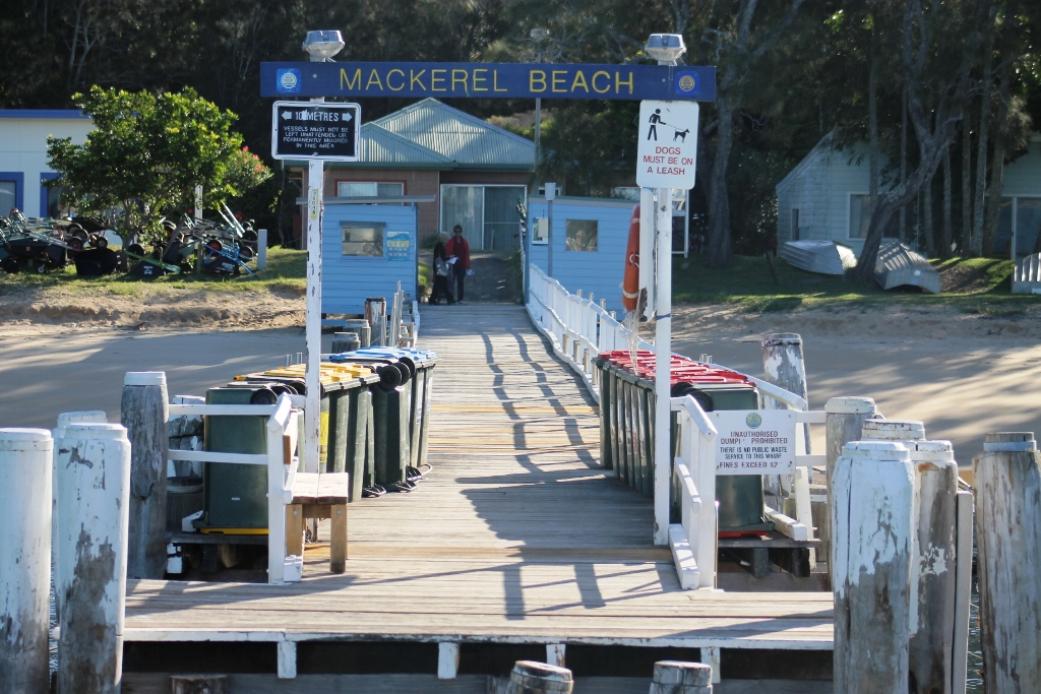
Ocean Beaches: Palm Beach To Manly
Details from all Ocean Beach in this LGA below.
Palm Beach: Very Good
Palm Beach is 2.3 km long, with rock baths in the southern corner. Lifeguards patrol the beach from September to April.
The Beach Suitability Grade of Very Good indicates microbial water quality is considered suitable for swimming almost all of the time, with few potential sources of faecal contamination.
Enterococci levels increased slightly with increasing rainfall, occasionally exceeding the safe swimming limit after 10 mm or more of rain, and often after 20 mm or more.
The site has been monitored since 1989.
Whale Beach: Very Good
Whale Beach is 600 m long, with rock baths at the southern rock platform. Lifeguards patrol the beach from September to April.
The Beach Suitability Grade of Very Good indicates microbial water quality is considered suitable for swimming almost all of the time, with few potential sources of faecal contamination.
Enterococci levels increased slightly with increasing rainfall, occasionally exceeding the safe swimming limit after 10 mm or more of rain.
The site has been monitored since 1989.
Avalon Beach: Very Good
Avalon Beach is 500 m long and backed by a park and picnic area. Lifeguards patrol the beach from September to April.
The Beach Suitability Grade of Very Good indicates microbial water quality is considered suitable for swimming almost all of the time, with few potential sources of faecal contamination.
Enterococci levels increased slightly with increasing rainfall, occasionally exceeding the safe swimming limit in response to 20 mm or more of rain.
The site has been monitored since 1989.
Bilgola Beach: Good
Bilgola Beach is 500 m long, with rock baths at the southern end. Lifeguards patrol the beach from September to April.
The Beach Suitability Grade of Good indicates microbial water quality is considered suitable for swimming most of the time but can be susceptible to pollution after rain, with several potential sources of minor faecal contamination.
Enterococci levels generally increased with increasing rainfall, occasionally exceeding the safe swimming limit after 10 mm or more of rain, and regularly after 20 mm or more.
The site has been monitored since 1989.
Newport Beach: Good
Newport Beach is an open, east facing beach around 1.3 km long. Lifeguards patrol the beach from September to April.
The Beach Suitability Grade of Good indicates microbial water quality is considered suitable for swimming most of the time but can be susceptible to pollution after rain, with several potential sources of minor faecal contamination.
Enterococci levels generally increased with increasing rainfall, occasionally exceeding the safe swimming limit after 5 mm or more of rain, and often after 20 mm or more.
The site has been monitored since 1989.
Bungan Beach: Good
Bungan Beach is 600 m long and backed by a steep escarpment. Lifeguards patrol the beach from late December to the end of January.
The Beach Suitability Grade of Good indicates microbial water quality is considered suitable for swimming most of the time but can be susceptible to pollution after rain, with several potential sources of minor faecal contamination.
Enterococci levels generally increased with increasing rainfall, occasionally exceeding the safe swimming limit in response to light rain, and often after 20 mm or more of rain.
The site has been monitored since 1989.
Mona Vale Beach: Very Good
Mona Vale Beach is 1 km long. Lifeguards patrol the beach from September to April.
The Beach Suitability Grade of Very Good indicates microbial water quality is considered suitable for swimming almost all of the time, with few potential sources of significant faecal contamination.
Enterococci levels generally increased with increasing rainfall, occasionally exceeding the safe swimming limit after light rain, and often after 20 mm or more.
The site has been monitored since 1989.
Warriewood Beach: Good
Warriewood Beach is 500 m long and located below a steep bluff. The beach is patrolled during holiday periods.
The Beach Suitability Grade of Good indicates microbial water quality is considered suitable for swimming most of the time but can be susceptible to pollution after rain, with several potential sources of faecal contamination including Warriewood Wastewater Treatment Plant (WWTP).
Enterococci levels generally increased with increasing rainfall, occasionally exceeding the safe swimming limit after 5 mm or more of rain, and regularly after 20 mm or more.
The site has been monitored since 1989.
Turimetta Beach: Good
Turimetta Beach is 350 m long and is backed by steep bluffs. This beach is not patrolled by lifeguards.
The Beach Suitability Grade of Good indicates microbial water quality is considered suitable for swimming most of the time but may be susceptible to pollution after rain, with several potential sources of faecal contamination including Warriewood WWTP.
Enterococci levels generally increased with increasing rainfall, occasionally exceeding the safe swimming limit after light rain, and often after 20 mm or more.
The site has been monitored since 1994.
North Narrabeen Beach: Good
North Narrabeen Beach is located at the northern end of the 3.5 km long beach and is patrolled from September to April.
The Beach Suitability Grade of Good indicates microbial water quality is considered suitable for swimming most of the time but may be susceptible to pollution after rain, with several potential sources of faecal contamination including discharge from Narrabeen Lagoon.
Enterococci levels generally increased with increasing rainfall, occasionally exceeding the safe swimming limit after light rain, and regularly after 20 mm or more.
The site has been monitored since 1989.
Narrabeen Lagoon (Birdwood Park): Poor
The Birdwood Park swimming site is a sandy beach on the southern side of the entrance to Narrabeen Lagoon. The lagoon entrance has been periodically open and closed at times.
The Beach Suitability Grade of Poor indicates microbial water quality is susceptible to faecal pollution, particularly after rainfall and occasionally during dry weather conditions, with several potential sources of faecal contamination including from elsewhere within the lagoon.
Enterococci levels increased with increasing rainfall, occasionally exceeding the safe swimming limit after no rain, and often after rain.
The site has been monitored since 2004.
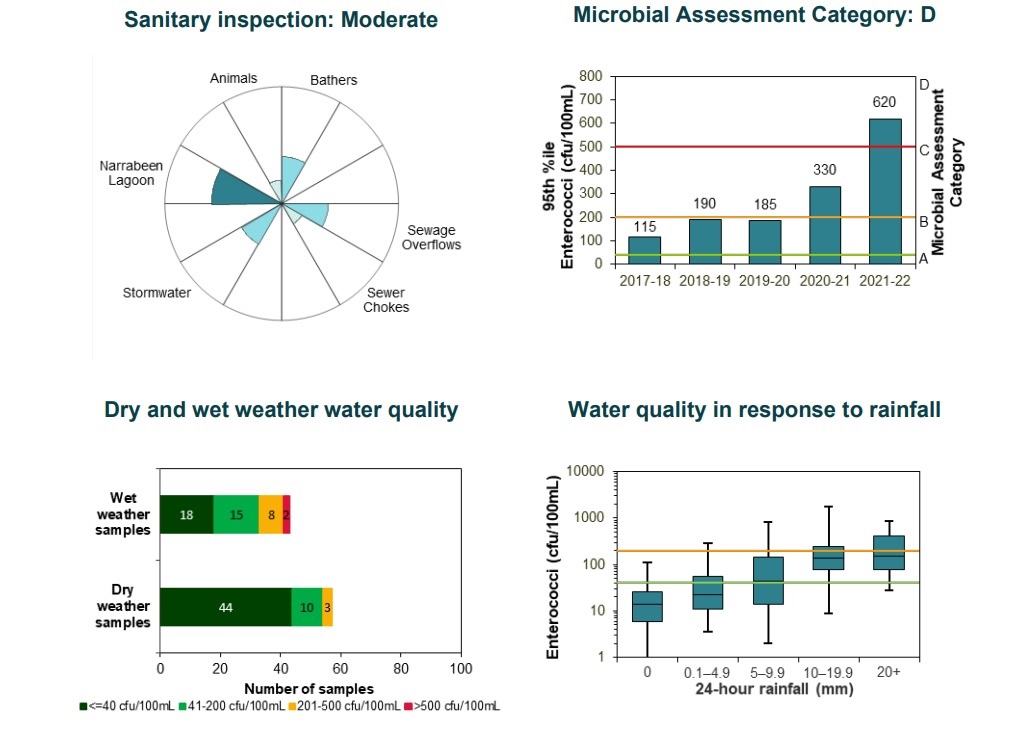
Birdwood Park Graph from State of the Beaches report 2021-2022
Bilarong Reserve: Poor
Bilarong Reserve is located on the northern shoreline of Narrabeen Lagoon.
The Beach Suitability Grade of Poor indicates microbial water quality is susceptible to faecal pollution, particularly after rainfall and occasionally during dry weather conditions, with several potential sources of faecal contamination including from elsewhere within the lagoon.
Enterococci levels increased with increasing rainfall, occasionally exceeding the safe swimming limit in response to no rain, and often after rain.
The site has been monitored since 2014.
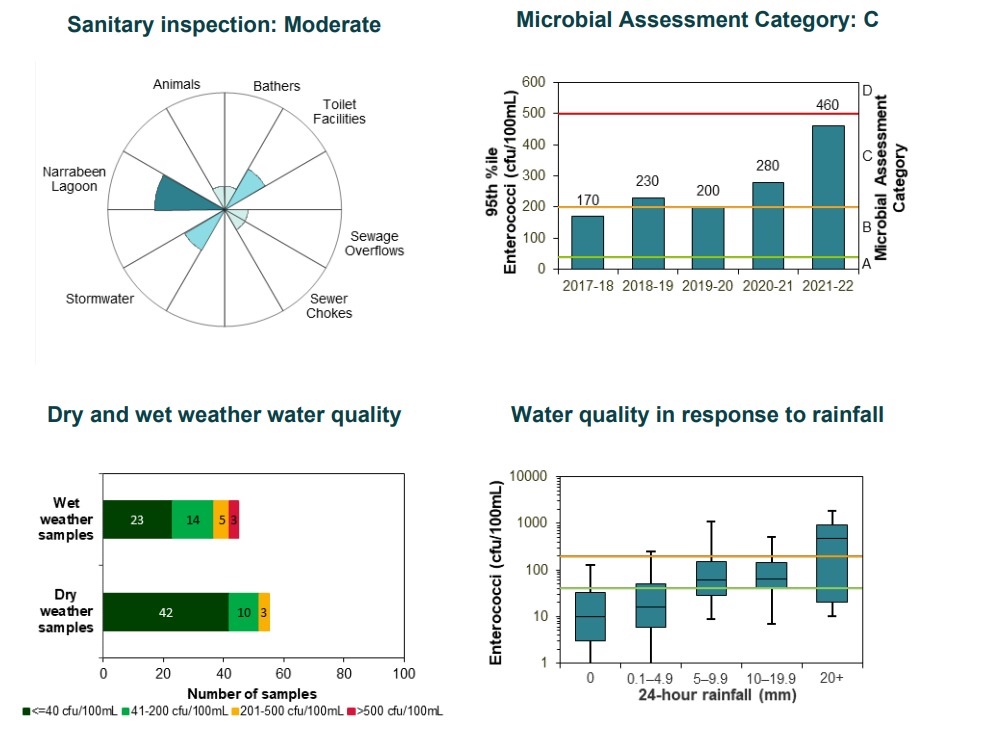
Bilarong Reserve Graph from State of the Beaches report 2021-2022
Collaroy Beach: Good
Collaroy Beach is backed by a park and picnic area. Lifeguards patrol the beach from September to April.
The Beach Suitability Grade of Good indicates microbial water quality is considered suitable for swimming most of the time but may be susceptible to pollution after rain, with several potential sources of faecal contamination including stormwater.
Enterococci levels increased with increasing rainfall, occasionally exceeding the safe swimming limit after light rain and often after 5 mm or more.
The site has been monitored since 1989.
Long Reef Beach: Good
Long Reef Beach is located near the entrance of Dee Why Lagoon. Lifeguards patrol the beach from September to April.
The Beach Suitability Grade of Good indicates microbial water quality is considered suitable for swimming most of the time but may be susceptible to pollution after rain, with potential faecal contamination from discharge from Dee Why Lagoon.
Enterococci levels generally increased with increasing rainfall, occasionally exceeding the safe swimming limit after 5 mm or more of rain, and often after 20 mm or more.
The site has been monitored since 1989.
Dee Why Beach: Good
Dee Why Beach is located at the southern end of the stretch of beach and is patrolled by lifeguards from late August to May.
The Beach Suitability Grade of Good indicates microbial water quality is considered suitable for swimming most of the time but can be susceptible to pollution after rain, with several potential sources of faecal contamination.
Enterococci levels generally increased with increasing rainfall, occasionally exceeding the safe swimming limit in response to 10 mm or more of rain, and regularly after 20 mm or more.
The site has been monitored since 1989.
North Curl Curl Beach: Good
North Curl Curl Beach is located near the entrance to Curl Curl Lagoon. Lifeguards patrol the beach from September to April.
The Beach Suitability Grade of Good indicates microbial water quality is considered suitable for swimming most of the time but may be susceptible to pollution after rain, with several potential sources of faecal contamination including discharge from Curl Curl Lagoon.
Enterococci levels generally increased with increasing rainfall, occasionally exceeding the safe swimming limit after 10 mm or more of rain, and frequently after 20 mm or more.
The site has been monitored since 1989.
South Curl Curl Beach: Very Good
South Curl Curl Beach is at the southern end of Curl Curl Beach and is patrolled by lifeguards from September to April.
The Beach Suitability Grade of Very Good indicates microbial water quality is considered suitable for swimming almost all of the time, with few potential sources of faecal contamination.
Enterococci levels generally increased with increasing rainfall, occasionally exceeding the safe swimming limit in response to 10 mm or more of rain, and regularly after 20 mm or more.
The site has been monitored since 1989.
Freshwater Beach: Good
Freshwater Beach is approximately 350 m long and is patrolled by lifeguards from late August to May.
The Beach Suitability Grade of Good indicates microbial water quality is considered suitable for swimming most of the time but may be susceptible to pollution after rain, with several potential sources of faecal contamination including stormwater.
Enterococci levels generally increased with increasing rainfall, occasionally exceeding the safe swimming limit after light rain, and frequently after 20 mm or more.
The site has been monitored since 1989.
Queenscliff Beach: Good
Queenscliff Beach is located at the northern end of Manly Beach. Lifeguards patrol the beach from September to April.
The Beach Suitability Grade of Good indicates microbial water quality is considered suitable for swimming most of the time but may be susceptible to pollution after rain, with several potential sources of faecal contamination, including discharge from Manly Lagoon.
Enterococci levels increased with increasing rainfall, occasionally exceeding the safe swimming limit after light rain, and regularly after 10 mm or more.
The site has been monitored since 1989.
North Steyne Beach: Good
North Steyne Beach is the middle section of Manly Beach. Lifeguards patrol the beach from September to April.
The Beach Suitability Grade of Good indicates microbial water quality is considered suitable for swimming most of the time but may be susceptible to pollution after rain, with several potential sources of faecal contamination including stormwater and discharge from Manly Lagoon.
Enterococci levels generally increased with increasing rainfall, occasionally exceeding the safe swimming limit after 5 mm or more of rain, and frequently after 20 mm or more.
The site has been monitored since 1989.
South Steyne Beach: Good
South Steyne Beach is at the southern end of Manly Beach. Lifeguards patrol the beach year round.
The Beach Suitability Grade of Good indicates microbial water quality is considered suitable for swimming most of the time but may be susceptible to pollution after rain, with several potential sources of faecal contamination including stormwater.
Enterococci levels increased with increasing rainfall, occasionally exceeding the safe swimming limit after no rain, and often after 10 mm or more.
The site has been monitored since 1989.
Shelly Beach: Good
Shelly Beach is backed by a picnic area and reserve and is not patrolled by lifeguards.
The Beach Suitability Grade of Good indicates microbial water quality is considered suitable for swimming most of the time, but may be susceptible to pollution after rain, with several potential sources of minor faecal contamination.
Enterococci levels increased with increasing rainfall, occasionally exceeding the safe swimming limit after little or no rain, and regularly after 10 mm or more.
The site has been monitored since 1989.
